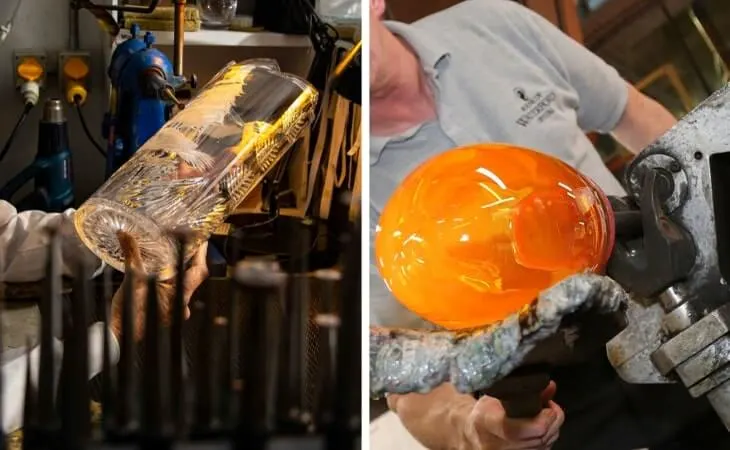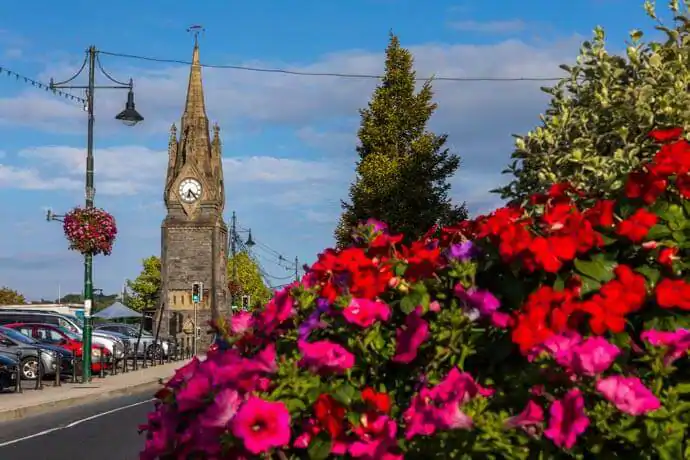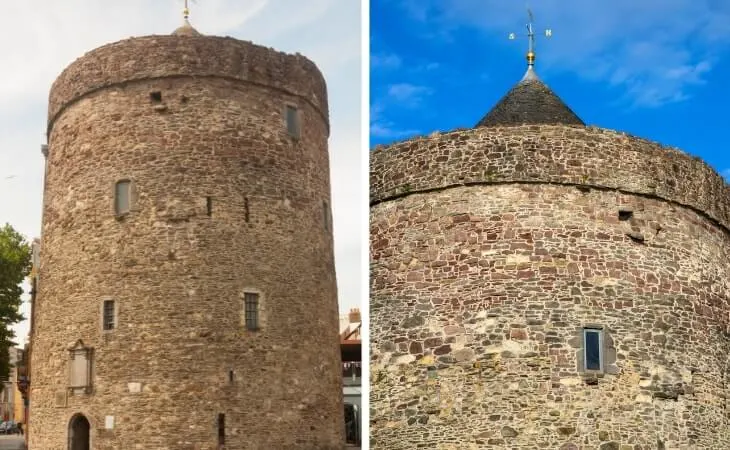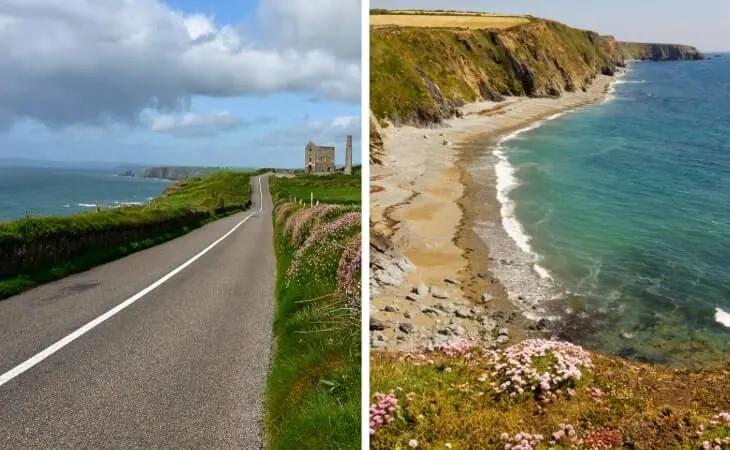The Viking Triangle in Waterford is packed with historical significance and a visit here is one of the more popular things to do in Waterford.
Waterford City, Ireland’s oldest city, boasts a staggering 1,100+ years of history dating back to the Vikings.
And it’s in Waterford’s aptly named ‘Viking Triangle’ where you can visit some of the city’s most prominent historical attractions.
In the guid below, you’ll find everything from what to see in the Viking Triangle in Waterford to where to visit close-by.
Some quick need-to-knows about the Viking Triangle in Waterford

Photos via House of Waterford Crystal on FB
Although a visit to the Viking Triangle in Waterford is fairly straightforward, there are a few need-to-knows that’ll make your visit that bit more enjoyable.
1. Location
The Viking Triangle is on the south bank of the River Suir in the heart of Waterford City. This historic area was surrounded by defensive walls and was originally a triangle of land between a branch of the St John’s River (now drained) and the River Suir.
2. Waterford’s Viking past
The Vikings settled in Waterford in 914AD, using it as a base for their coastal and inland raids using longships. They established another settlement 5km upriver at Woodstown, a rich archaeological site excavated in 2003. More on this below.
3. The ‘Epic’ Tour
The Epic Tour (affiliate link) is a fun way for groups and individuals to enjoy a whistle-stop tour around the main sights of the Viking Triangle in Waterford with a storyteller-historian-guide. This interactive experience includes access to five national monuments as you zip through the historic streets in the wake of your larger-than-life guide.
About the Viking Triangle in Waterford

Photo by chrisdorney (Shutterstock)
Th Vikings chose to settle in Waterford on a triangle of land between two rivers. Easy to defend and with access to coast and inland rivers for their raids, it was an ideal spot for the Vikings to use as a base and settlement. It established a hub for international trade.
Now an area of narrow winding streets that were once within the 100-year-old Viking city walls, the Viking Triangle is a cultural and historic hub.
It is home to three historic museums including Reginald’s Tower, the Medieval Museum and the Bishop’s Palace. Together they cover the city’s Viking, Medieval and Georgian history.
Beneath the streets, the Medieval Museum includes access to the 13th-century Choristers’ Hall and the 15th century Mayor’s Wine Vault. The Viking Triangle also offers a Viking House 3D Experience and there’s an Epic Tour (affiliate link) if you want to see it all in one guided interactive jaunt.
Christ Church Cathedral and the House of Waterford Crystal are on the edges of this remarkable historic area and both are worth a visit, too!
Places to visit in the Viking Triangle
One of the beauties of the Viking Triangle is that it’s home to some of the best places to visit in Waterford.
From the Viking Sword and Reginald’s Tower to the Medieval Museum and more, you’ll discover loads to explore within the Viking Triangle in Waterford below.
1. Reginald’s Tower

Photos via Shutterstock
The landmark round tower in Waterford’s Viking Triangle is known as Reginald’s Tower. It’s s the oldest civic building in the city and the only monument in Ireland to retain a Viking name.
The current tower was constructed around 1253, replacing an earlier tower. Standing 16m high, it has had various uses including watchtower, mint, prison, munitions store, royal castle (visited by King John) and an air raid shelter.
Now a dedicated Viking museum, it is crammed with interesting exhibits dating back to 914AD. Many of the exhibits were uncovered during an archaeological dig at the Viking settlement at nearby Woodstown in 2003.
2. The Medieval Museum
Housed in a unique building that incorporates two underground medieval halls, the Medieval Museum is anything but boring! Guided tours take visitors down to the 800-year-old Choristers’ Hall and the 15th century Mayor’s Wine Vault.
Discover their interesting past history before admiring magnificent exhibits include the Great Charter Roll of Waterford. Don’t miss the the Sword of Edward IV, the Luker Chalice, Henry VIII’s Hat and the sumptuous cloth-of-gold vestments made of Italian silk.
The Mayors’ Treasury highlights the names of 650 mayors of the city since the 12th century and a collection of lavish gifts.
3. Waterford Crystal

Photos via House of Waterford Crystal on FB
Arguably Waterford’s most famous export, Waterford Crystal brought prosperity to this historic port city from the 18th century. Learn about the ups and downs of this international company on a guided factory tour.
The new Visitor Centre is in the heart of the Viking Triangle and the onsite factory produces 750 tonnes of quality crystal every year. See the skilled craftsmen demonstrating the ancient art of glass-blowing, cutting, sculpting, etching and engraving by hand.
The fascinating tour ends in an amazing museum with the largest collection of Waterford crystal in the world.
4. Bishop’s Palace

Photo via Google Maps
From the oldest surviving Waterford Crystal decanter to the 1960s Hucklebuck shoes, the impressive Bishop’s Palace Experience tells a fascinating tale of local life in Waterford City.
Historians and war veterans will be intrigued by the Dead Man’s Penny, given to a local family in memory of their son, the youngest to die at the Battle of Ypres.
See Napoleon’s Mourning Cross and discover the connection with the city and admire the ceremonial US sword given to Irish nationalist, Brigadier-General Thomas Francis Meagher. It’s another amazing story!
5. Christ Church Cathedral

Photo by chrisdorney (Shutterstock)
This compact and beautiful protestant cathedral is one of Ireland’s most historic buildings. The earliest building on this site was where Strongbow (second Earl of Pembroke) tied the knot with Aoife, daughter of Diarmait Mac Murchada, King of Leinster in 1170.
In the 18th century, a new cathedral was planned, designed by Georgian architect John Roberts. During demolition of the old cathedral in 1773, a collection of medieval vestments were discovered. They are now on display in the Medieval Museum in Waterford. This lovely cathedral was completed in 1779 and has a pillared altar with Hebrew letters on it.
6. Viking Sword and Longboat

Photo via Google Maps
Stroll along Bailey’s New Street and you’ll come across an unexpected sight – a Viking Sword and Longboat. The Viking Sword is a beautifully carved piece by John Hayes measuring 23m in length and created from a single tree trunk. In fact, the roots are still attached as part of the sculpture.
Further down the street is the 12m Viking Longboat outside Reginald’s Tower. Both pieces are intricately carved with details of Waterford’s remarkable history. There’s no opening hours and no cost to see these outstanding relics.
7. The Viking House
The remarkable Viking House is a 3D experience. Best be warned, not everything is quite as it appears in this virtual reality King of the Vikings attraction.
Located in the Viking Triangle, the thatched house was handcrafted as a replica of an authentic Viking House. It stands in the ruins of a 13th century Franciscan Friary.
Book your 30 minute virtual experience that takes you back in time in this historic city of the Vikings. Entry is 10€ for adults and 5€ for children under 12.
Things to do near the Viking Triangle in Waterford
After you’ve finished exploring Waterford’s Viking Triangle, you’re a stone’s throw from plenty of other things to do.
Below, you’ll find everything from places to eat and scenic drives to the brilliant Waterford Greenway.
1. Post tour food in the City

Photos via Sheehan’s Restaurant on Facebook
If you fancy a post ramble feed, there are plenty of great restaurants in Waterford to nip into, from fine dining to casual, tasty eats. There’s also plenty of great, old pubs in Waterford if you fancy a tipple.
2. The Waterford Greenway

Photo by Elizabeth O’Sullivan (Shutterstock)
Stretching southwest from Waterford to Dungarvan, the Waterford Greenway is Ireland’s longest off-road trail. This 46km former railway track takes in historic pubs, churches, Norman castles, deserted railway stations, viaducts, river valleys, bridges and breathtaking scenery.
3. The Copper Coast

Photos via Shutterstock
Waterford’s Copper Coast is a UNESCO Global Geopark extending along the Atlantic coast for 25km. It takes its name form the 19th century copper mines that riddle this spectacular area of cliffs, coves and beaches. The area runs from Fennor in the east to Stradbally in the west and north to Dunhill. Here’s a guide to the route.
FAQs about the Viking Triangle Waterford
We’ve had a lot of questions over the years asking about everything from what are the best things to do in the Viking Triangle to what to see nearby.
In the section below, we’ve popped in the most FAQs that we’ve received. If you have a question that we haven’t tackled, ask away in the comments section below.
What is there to see in the Viking Triangle in Waterford?
You’ve everything from Reginald’s Tower and the Medieval Museum to the Viking House, a big aul sword and much more (see guide above).
Is the Viking Triangle worth visiting?
Yes! The Waterford Viking Triangle is packed with history, and it’s a great place, in particular, to spend a rainy day, as many attractions are indoor.
What period is associated with the Viking Triangle?
Waterford City was founded in 914 A.D. and this is where the story of the Viking Triangle all begins.

